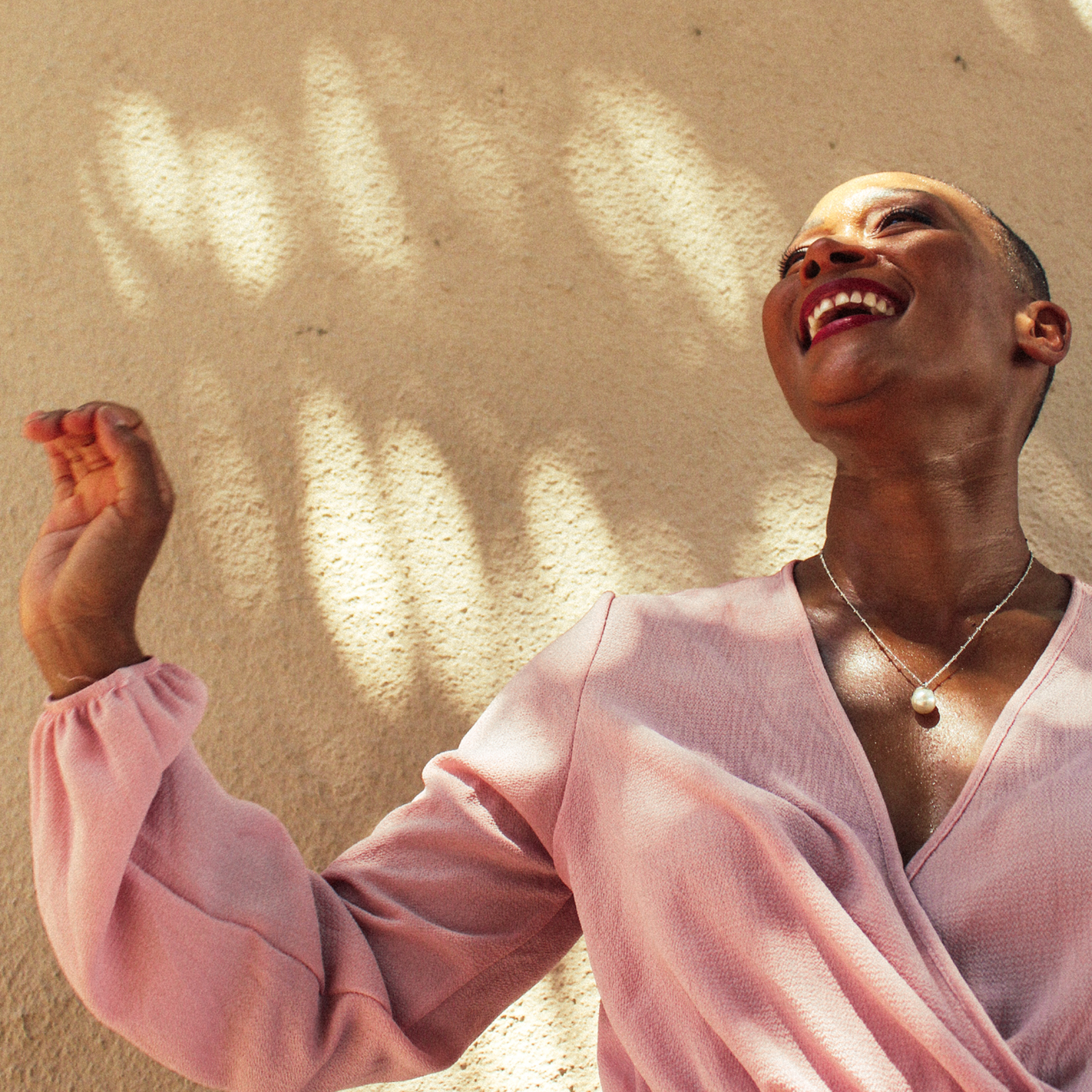Beauty in Safe Spaces with Artist Gisela McDaniel: Honoring the Stories of Survivors Through Painting
Interview by: Alana Eastling
Editor: Jeni Fjelstad
Creative Direction: Catie Menke
Gisela McDaniel is a diasporic indigenous CHamoru artist, who channels her own healing journey as a survivor of sexual assault into an artistic practice of extended healing to those in her community. Her sculptural oil portraits showcase the stories, voices, and bodies of primarily women and non-binary people who identify as indigenous, multiracial, immigrant, and of color.
Each portrait is completed by an audio element, sharing the voice of the subject via motion-sensored technology. While I recommend observing Gisela’s work in person, consuming her work digitally is such a privilege and has a moving impact. As her cousin, I have always been an admirer of her talent. But the experience of this conversation built upon the impact of previously participating in one of her works, the gift of her story — her perspective and her process of healing is transformative.
Gisela honors the beginning of healing from her own sexual trauma by empowering and healing other survivors in cultivating spaces to honor their stories. We spoke on the beauty of safety in sharing these weighted stories and her practiced intention to create safe spaces for subject-collaborators to share and be heard.
“I’m happy to live in a world where I genuinely feel things shifting,” she said. “We have the space to actually speak [our stories] and have them be received. Not in a perfect way most of the time, or ever, but we have space.”
The first step in Gisela’s healing journey began by seeking out women who had similar experiences. These women granted her safety, to be held and heard in vulnerability about her experience.
“I still think about those women who have affirmed me in really difficult moments, who have witnessed my experience and gifted me the language to speak to what happened,” she said. “Without those conversations, I would have never been able to be here today.”
In communication with friends and other women around her, Gisela approaches every connection as an opportunity to learn through the gift of someone else’s perspective, which is ultimately the goal of her work.
The second half of her healing journey was reclaiming her narrative and body through art, a process she believes found her through necessity.
“I started to draw myself because I needed a better relationship with myself,” she said. “When I was able to sit with my body, in almost a meditative way and appreciate myself, thank my body for being here and moving through these things, that was really healing for me. And I wanted to be able to do this for other people.”
I’ve had the privilege of being the subject of one of Gisela’s paintings. The conversation we shared about learning and reclaiming our indigenous CHamoru heritage outside of our Nana and Tata, who passed, was a turning point in my own journey. We talked together about what healing from colonization and white supremacy looks like. Participating in each layer of her practice opened up a deeper layer to my healing.
Gisela also shared about how her indigeneity plays into this healing. She recounted conversations with fellow activists and CHamoru artists about the “parts of our culture that should just be for us, that don’t need to be consumed in the art world or consumed in other ways.”
Gisela prioritizes respect for and permission from her subject-collaborators, she celebrates ancestor magic in honoring objects and the places we come from. Moreover, she weaves voices together in the audio elements of her work. Through these cultural values and practices, Gisela has discovered less obvious ways to express our CHamoru heritage into her artistic process.
What I find most impressive and empowering about Gisela’s work is how she is able to capture the emotion — the soul — in the eyes of her subject-collaborators on canvas. She graciously accepted my compliment but insisted that each layer of her artistic process is collaborative. The foundation is an exchange of conversation, connection, and establishing a relationship. She is dedicated to creating a comfortable, judgment-free, and consensual environment for her subject-collaborators to share their stories.
Many of the people she interviews may be telling their whole story for the first time, from start to finish.
“I think it’s empowering to be able to speak [your full story] and be like, ‘yeah, this happened, but it doesn’t define me,’” she said. “What defines me is the way I move through that, grow through that, and come out the other side stronger. To be able to celebrate that, and capture that, it has a lot to do with the people in the painting.”
Drawing from her need to reclaim her own narrative in her healing journey, Gisela facilitates the same opportunity for her subject-collaborators throughout each layer of her work.
At the end of these conversations, she photographs her subject-collaborators, the only direction given is to make eye contact.
“I think there is something really magical about that moment — the intimacy in just [having shared] these stories, and their trust,” she said. “We are still in that moment.”
Gisela describes receiving each of these conversations as a gift and reflects on how to handle it with care, how to treat it gently, and what this person would want to see out of this work. In how she speaks to the humbling experience of people trusting her with their stories and in my own witnessing of her process, Gisela’s care and respect for her subject-collaborators are profound.
The next layer to her work is oil painting, which consists of literal layers of paint itself.
Gisela references the histories of oil painting: “We weren’t the people being painted — especially not these stories. If [paintings were of] women, you didn’t know their name or they weren’t even looking — it was very extractive.”
Even before discovering her own practice, Gisela would look at paintings, particularly of women and people of color, and wonder how the subjects felt about the painting or if they even liked it. She approaches her work as an opportunity to honor her subject-collaborators by creating a lasting image of them and their stories.
“I want to have them remembered in the most regal, elegant way,” she said. “It’s a celebration.”
She views these shared conversations and stories as histories that normally wouldn’t be recorded but are important knowledge to immortalize in how we move through the world.
The final layer in creating her work is the element of sound: the subject-collaborator’s voice in the space.
Gisela weaves audio pieces of these conversations to be paired with each painting using motion-sensored technology. Her integration of audio is a protective element.
“Once the painting is going out into the world, going to an exhibition, I feel the need to protect it in some way and that’s where the voice element comes in,” she said. “I don’t want these [pieces] to be consumed without folks being able to speak for themselves.”
As these stories can be full of difficult and heavy language, the experience of listening to them can be intense. During her conversations, Gisela uses visualization of these words rolling onto the floor; they are something to release and walk away from rather than storing them in her or the subject-collaborators’s bodies.
“I try to paint that moment of release and walking away,” she said. “Those words do have to go somewhere, and [the audio element lets them] fall onto somebody else’s ears. When you speak something, you release it. It’s no longer just your responsibility anymore. It’s anybody who hears its responsibility in a way.”
Similar to her painting practice, the goal of Gisela’s art works in layers as well. First, the ripple effect her own healing journey has had on individuals in her community. We all carry stories of our own suffering and “to be able to unpack that, talk about it, is not going to be easy, and it’s not always going to make sense. But making that effort is a step in the right direction for me. That is what I am hoping to contribute to the world.”
The space and empowerment Gisela facilitates for her collaborators is such a special and necessary form of healing.
In the portrait she painted of my sisters and I, she created a visual representation of our resilience and strength in a way I had not seen before. Sharing these collaborative perspectives is the foundation of the impact of her work: for those in the paintings and those who witness the visual and audio elements of these stories.
“I hope people experience the gift of this person, [their] voice and story and it changes the way they move, to treat people with grace and respect,” she said. “Whether that’s in their relationships, with themselves, with strangers. For me, the work would be successful if it actually implements some kind of change.”
On an individual level, I know Gisela and her art have been implementing change. With her continued work and global reach, I have no doubt the impact will affect change on a societal level as well.
Thank you, Gisela, for giving us this conversation and the heart that you bring to healing our world. There is much to learn from your story of committed and intentional healing and how sharing that with others can cause a virtuous cycle of healing. The talent and intention in your craft are impeccable. You are truly a treasure.
Connect with Gisela at giselamcdaniel.com.





















